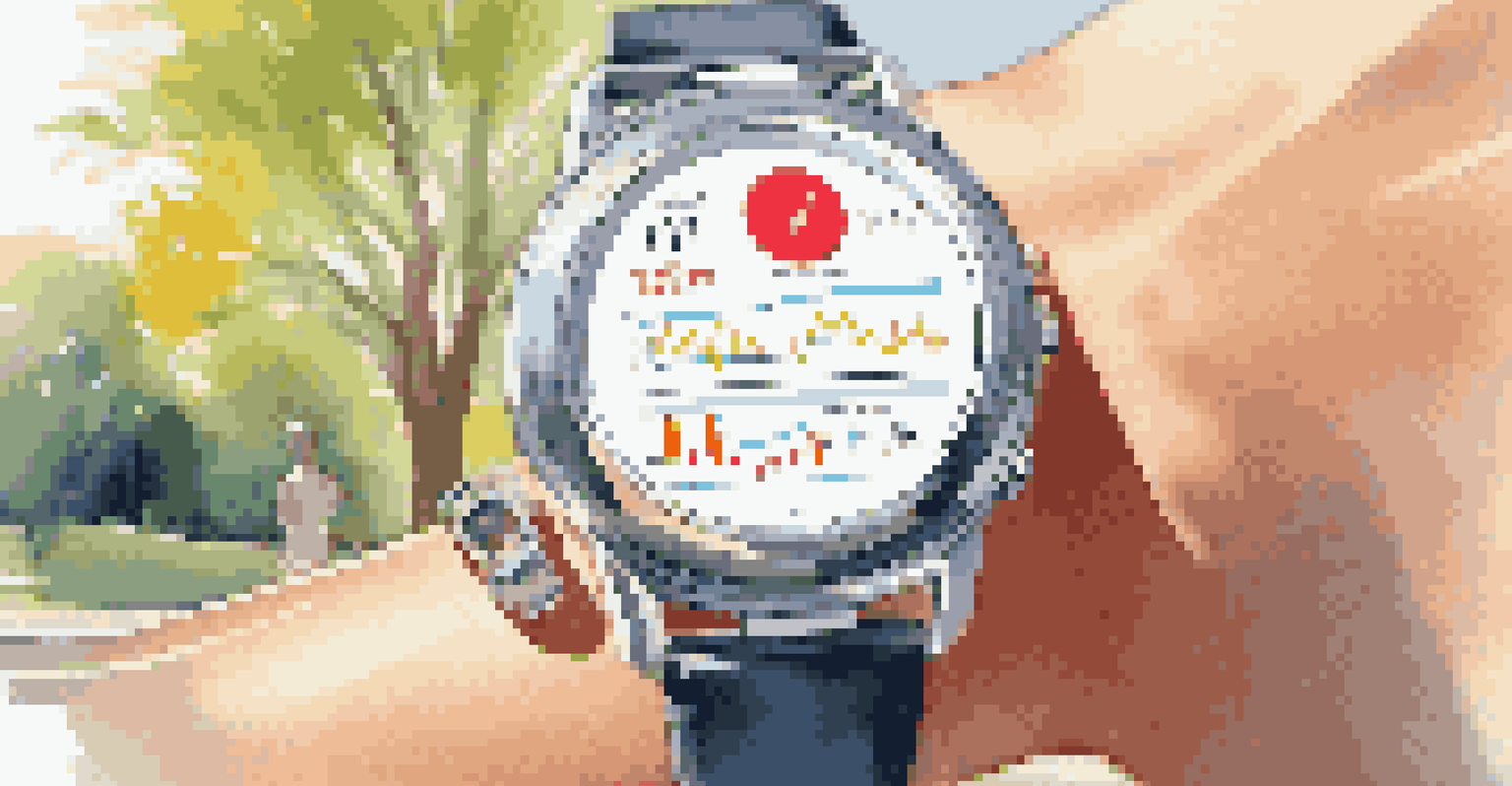Innovations in Wearable Tech: What to Expect in 2024

The Rise of Health Monitoring Wearables
In 2024, we can expect a significant leap in health monitoring wearables. These devices will not only track heart rates and steps but will delve deeper into health metrics, such as blood glucose levels and hydration status. Imagine a smartwatch that can alert you when your hydration levels drop, helping you stay on top of your health effortlessly.
Wearable technology is not just about tracking health metrics; it's about creating a holistic approach to well-being.
This innovation is particularly exciting for individuals managing chronic conditions. By providing real-time insights, these wearables can empower users to make informed decisions about their health. It's like having a personal health assistant on your wrist, ready to guide you through your daily wellness journey.
Moreover, the data collected will likely integrate seamlessly with telehealth services, allowing healthcare professionals to monitor patients remotely. This shift can lead to more proactive healthcare, reducing hospital visits and ensuring timely interventions when necessary.
Enhanced Fitness Tracking Features
As fitness enthusiasts continue to seek more personalized experiences, wearable tech is evolving to meet these needs. Expect devices that offer advanced tracking for various activities, from yoga to high-intensity interval training (HIIT). These wearables will analyze your workouts with precision, providing insights on form, intensity, and recovery.

For example, imagine a fitness band that can detect your muscle fatigue during a workout and suggest rest periods accordingly. This level of personalization not only enhances performance but also minimizes the risk of injury, making your fitness journey safer and more effective.
Wearables Enhance Health Insights
In 2024, health monitoring wearables will provide deeper insights into metrics like blood glucose and hydration, acting as personal health assistants.
Furthermore, integration with augmented reality (AR) could offer innovative workout experiences, where users can see their performance stats displayed in real-time through smart glasses. This combination of technology and fitness will create a more engaging and motivating workout environment.
Fashion Meets Functionality in Wearables
Fashion-forward wearables are set to make waves in 2024, with designs that prioritize aesthetic appeal without compromising functionality. Brands are increasingly collaborating with fashion designers to create stylish smartwatches and fitness trackers. The goal is simple: to ensure that tech-savvy consumers can wear their devices with pride.
The future of wearable tech lies in its ability to integrate seamlessly into our daily lives, enhancing our health and connectivity.
Imagine a smartwatch that looks like a designer piece, blending seamlessly with your outfit while still offering cutting-edge technology. This trend is all about making wearables a part of daily fashion rather than just a tech accessory. Who says you can't look good while staying connected?
Additionally, materials used in these devices are becoming more sustainable, aligning with the growing demand for eco-friendly products. As consumers become more environmentally conscious, fashion in wearable tech will reflect those values, creating a win-win situation for style and sustainability.
The Role of AI in Wearable Technology
Artificial intelligence (AI) is transforming the landscape of wearable tech, making devices smarter and more intuitive. In 2024, we can expect wearables to learn from user behavior, providing personalized recommendations based on collected data. It's like having a personalized coach that adapts to your lifestyle and fitness goals.
For instance, if you consistently skip workouts on Mondays, your device might suggest alternative activities or motivational content to encourage consistency. This level of customization not only improves user engagement but also fosters healthier habits over time.
Fashionable and Functional Tech
The integration of style and technology in wearables will allow consumers to express themselves while enjoying advanced health tracking features.
As AI capabilities grow, we may see features like predictive health alerts, allowing wearables to warn users of potential health issues before they arise. This proactive approach could revolutionize how we manage our health, leading to a more informed and health-conscious society.
Integration of IoT with Wearable Devices
The Internet of Things (IoT) is creating a connected ecosystem where wearables communicate with other smart devices. In 2024, this integration will enhance user experiences, allowing wearables to control various aspects of daily life. Think of it as your wristband acting as a remote control for your smart home.
For example, imagine walking into your home and your wearable automatically adjusts the lighting, plays your favorite playlist, and sets the thermostat to your preferred temperature. This level of convenience is not just a luxury; it could become a standard expectation for tech-savvy consumers.
Moreover, this connectivity will enable wearables to gather data from various devices, providing a holistic view of health and lifestyle. By analyzing this comprehensive data set, users can make more informed choices that positively impact their well-being.
Improved Battery Life and Charging Solutions
Battery life has always been a concern for wearable technology, but innovations in 2024 promise to address this issue. Expect devices with longer-lasting batteries, allowing users to wear them for days without needing a charge. This enhancement will make wearables more reliable and convenient for everyday use.
Additionally, advancements in charging solutions, such as solar-powered and kinetic charging, are on the horizon. Imagine a smartwatch that charges as you move throughout the day, harnessing energy from your activities, making dead battery anxiety a thing of the past.
AI and IoT Transform Wearables
Advancements in AI and IoT will make wearables smarter and more connected, enhancing user experiences through personalized recommendations and home automation.
With these improvements, users can enjoy their wearables' features without interruptions, leading to a more seamless integration of technology into their daily lives. Longer battery life means more time to focus on health and wellness, rather than worrying about charging schedules.
Privacy and Security in Wearable Tech
As wearable technology continues to evolve, so do concerns about privacy and data security. In 2024, we can anticipate stronger measures to protect user data, ensuring that health metrics and personal information remain safe. This focus on security is critical as more sensitive data is collected through wearables.
For instance, companies might implement advanced encryption methods and user consent protocols, giving users greater control over their data. Users will likely have the ability to decide who accesses their information and how it is used, fostering trust between consumers and manufacturers.

Furthermore, awareness campaigns about data privacy will educate users on best practices for safeguarding their information. As wearables become more integrated into our lives, prioritizing privacy will be essential to maintain user confidence in these technologies.
The Future of Wearable Tech: What's Next?
Looking ahead, the future of wearable technology is brimming with possibilities. With advancements in materials science, AI, and connectivity, we can expect devices that are not only smarter but also more responsive to our needs. The convergence of these technologies will pave the way for innovations we can only imagine today.
Future wearables may even incorporate features like brain-computer interfaces, allowing for a direct connection between our thoughts and technology. This could revolutionize how we interact with devices, making controlling technology as simple as thinking about it.
Ultimately, as we move into 2024 and beyond, the focus will be on enhancing user experience and well-being. With each innovation, wearables will continue to empower users, helping them lead healthier and more connected lives.